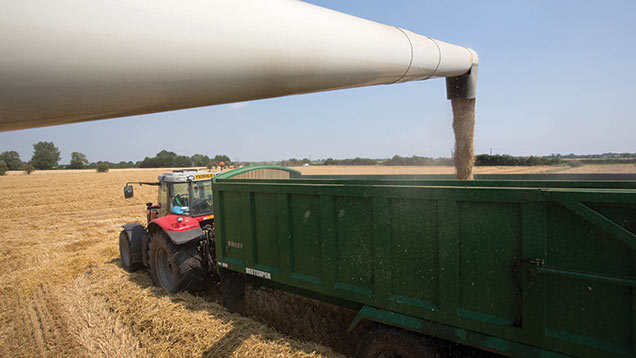Researchers aim to make precision farming pay
 © Tim Scrivener
© Tim Scrivener More than a decade ago, HGCA-funded trials suggested varying N fertiliser rates within a field could save on average £22/ha. At today’s prices, that equates to £48/ha.
Since the advent of yield monitors, the cost-effectiveness of precision management has been evaluated by many, both in the UK and abroad. But it is fraught with difficulties – statistical and otherwise, warns Ben Marchant of the British Geological Survey.
See also: Barley study aims to cut skinning risk and protect margins
“Yield data gathered by software on combines isn’t always good enough to produce precise maps. Then comes the problem of interpreting the maps – there is no consensus on the best analysis methods.
“We set out to fine-tune programs to generate robust maps and assist precision agriculture specialists in giving recommendations for N, P and K use within fields, to optimise farm profitability.”
Better data
The first step was to improve yield-mapping programs. That itself proved difficult – yield monitor data are often noisy and artefacts (spurious data) can confuse the picture, says Dr Marchant.
Furthermore, there is usually a five- to seven-second time lag between where the yield measurement is taken and where it is recorded on a map, which skews the result.
It seemed more appropriate to design a new program with a novel method for detecting and correcting for this time lag. It can also adjust for GPS anomalies and intermittent grain flow, he explains.
Having produced reliable maps, Alice Milne and Shibu Muhammed from Rothamsted Research are helping him develop computational methods that determine, using cluster analysis, different management zones based on the yield monitor data. Some fields contain up to five distinct regions, colour coded on the map.
The next stage is to compare sampling approaches for soil nutrient measurements and develop a protocol for zone delineation. Currently, precision management companies use a range of methods. Soyl, for example, measures nutrients on a 100m grid and can vary fertiliser treatments every few metres.
The researchers are working with 15 years worth of field data on grain yield, collected by Soyl via GPS-tracked yield monitors on combines along with soil nutrient measurements and weather information. They are looking for features within and across different seasons that may explain yield variations.
Field map showing management zones

An example map showing three management zones in a field. By cleaning up yield data, researchers hope to produce more robust zones.
Low-yielding areas
“When a low-yielding region is identified, the farmer is often unsure how to respond because there are many factors which could limit the yield. We are consulting specialists such as Soyl to identify patterns within management zones and between different seasons, to pinpoint the reasons for variability.”
If yield is poor in an area, it may be necessary for more drastic measures such as addressing soil compaction or poor drainage, he explains. However, in many circumstances variable-rate fertiliser additions can address in-field variation.
Using recommendations from Defra’s fertiliser manual RB209, the team is calculating the amounts of N, P and K fertiliser needed in each identified management zone. The cost-effectiveness of fertiliser treatment will be ascertained and its environmental impact quantified.
By the end of the project, Dr Marchant hopes to have reliable models and software to determine the circumstances where variable-rate fertiliser applications are likely to be cost effective.
“We are confident we will have all the necessary tools to assess the value of yield maps and advise growers when they might be used to define distinct management zones. Then they will know where to use a variable rate spreader, he says.
The technology may later have other applications, such as for varying seed rates within a field, he concludes.
Research reasons
This project aims to determine when it is cost effective for growers to use yield maps and management zones to guide soil management decisions, and develop protocols for robust and efficient implementation
Project: Exploiting yield maps and soil management zones
Timescale: January 2013 – January 2016
Researchers involved: British Geological Survey, Rothamsted Research and SOYL
Funders: HGCA
Cost: £202,308
Key points
- Produced software for making robust yield maps and delineating management zones
- Visualised zones to help growers determine what is causing variations
HGCA perspective
by Amanda Bennett Research and knowledge transfer manager, HGCA
“Our aim is to improve yield mapping software so yield data from several harvest years can be processed more reliably. We hope to see a new range of software tools developed to help growers identify robust soil management zones. In addition to the software, we plan to produce guidance on better understanding the underlying causes of variability and how to adapt management practices.”

